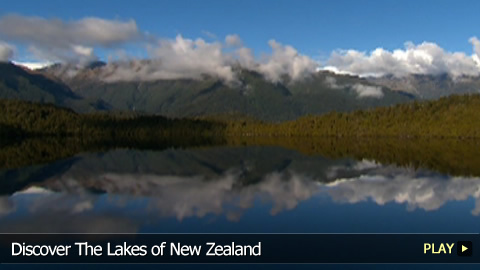Discover The Lakes of New Zealand

advertisement
VOICE OVER: Rebecca Brayton
Though New Zealand is comprised of two main islands, the majority of the country's lakes are located on its South Island. The largest, Lake Taupo is surrounded by thriving geothermal activity, evidence of the ancient volcanic eruption that originally helped form the body of water. Lake Wakatipu is New Zealand's longest lake, and in fact the country's third largest. It is shaped like a lightning bolt, and is bordered by mountains. Lake Wanaka is popular for fishing, boating and swimming, and is the fourth-largest lake in New Zealand. In this video, http://www.WatchMojo.com takes a look at these and more of New Zealand's most beautiful lakes.
The majority of the lakes located on New Zealand’s North Island trace their origins to volcanic activity, while those on the South Island were sculpted by glaciers.
Lake Taupo is about the size of Singapore, and is the largest lake in New Zealand. A well-known trout fishery, this area draws well over one million visitors annually, especially during the holiday season. Lake Taupo is located in a hollow that was formed as a result of a huge volcanic eruption. This influence is still visible today in the geothermal activity that thrives around this lake.
Lake Wakatipu is New Zealand’s longest lake, and in fact the third largest. It is shaped like a lightning bolt, and is bordered by mountains. Because of its strange shape, the lake has a sort of tide that cause the water to rise and fall significantly in short periods of time. The T.S.S. Earnslaw is a vintage paddlesteamer that cruises the lake daily.
Lake Wanaka is the fourth-largest lake in New Zealand, and is located 915 feet above sea level. This lake sits in a u-shaped valley that was formed during the last ice age. Today, Lake Wanaka is popular for fishing, boating and swimming.
Lake Manapouri is the second-deepest lake in New Zealand. It is found on the edge of Fiordland National Park, and serves as a base for visitors who wish to experience the glaciers.
Lake Rotorua is part of a group of about twenty lakes that was once referred to as The Hot Lakes. Of this group Rotorua is the largest, and it is the second-largest lake on New Zealand’s North Island. The lake has a high sulfur content due to its proximity to volcanic activity. This presence of sulfur gives the water a atypical yellowish-green tint.
Because of their idyllic beauty, the lakes of New Zealand can be considered top tourist destinations all on their own.

